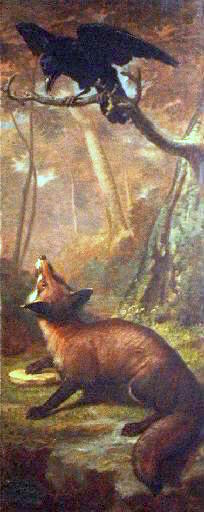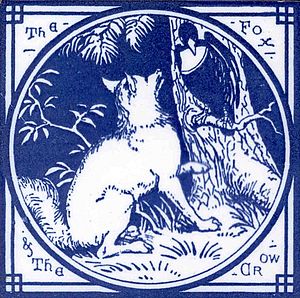The Fox and the Crow (Aesop) facts for kids
The Fox and the Crow is a famous story from Aesop's Fables. It's story number 124 in a special list called the Perry Index. People have known this story for a very long time, with early versions found in Latin and Greek writings from about 2,000 years ago. Some even think it might have been shown on an ancient Greek vase! The main idea of this fable is to teach us to be careful about people who try to trick us with too much praise.
Contents
The Story of the Fox and the Crow
In this well-known fable, a crow finds a tasty piece of cheese. It flies up to a tree branch to enjoy its snack in peace.
A clever fox sees the crow with the cheese and wants it for himself. The fox starts to praise the crow, saying how beautiful it is. He then asks if its voice is as sweet as its looks.
The crow, feeling proud from the fox's compliments, opens its beak to sing a loud "caw!" As it does, the cheese falls from its mouth. The quick fox immediately grabs the cheese and eats it.
The story teaches us a simple lesson: be careful of people who flatter you too much. They might be trying to get something from you! One old version of the story has the fox tell the crow, "You have everything, Sir Crow, except brains."
Some people even wrote a follow-up song where the crow is happy the fox is gone. Another writer, Gotthold Ephraim Lessing, changed the story. In his version, the fox dies after eating poisoned meat that the crow dropped. This showed that flatterers might get what they deserve.
Interestingly, a similar story exists in Buddhist writings. In that tale, a jackal praises a crow, and the crow shares fruit with the jackal. This shows that not all praise is bad, especially when it leads to sharing.
Even older, a painting on a vase found in Lothal (from the ancient Indus Valley Civilisation) might show this story. This suggests the tale could be thousands of years old!
Music Inspired by the Fable
Many French composers have created music based on "The Fox and the Crow." This is because the fable is often the first one French children learn by heart from La Fontaine's Fables.
Some of the famous composers who set the fable to music include Jacques Offenbach and Charles Gounod. There are songs for voices, and even pieces for orchestras.
The fable has also inspired music in other countries. A Dutch composer, Rudolf Koumans, wrote a version for a school chorus. A Spanish composer, Xavier Benguerel i Godó, set a Catalan translation of the fable to music.
The story has even been turned into children's operas, like "La Fontaine and the Crow" by Isabelle Aboulker. Other composers, like David Edgar Walther, also used it in their musical plays.
The fable has appeared in popular music too! The French group Dynastie Crisis made an early rap version in 1970. Even Sesame Street has a folk version of the story. The band Black Oak Arkansas retold the story in their song "Sly Fox." The band mewithoutYou also made a song called "The Fox, The Crow, and the Cookie," which updates the fable.
Art and the Fable
"The Fox and the Crow" has appeared in many different kinds of art. For example, it is shown three times on the famous Bayeux Tapestry. Some people think these pictures might have had a hidden political meaning long ago.
The fable has also been seen in church buildings, like on a column in a church in Spain. In later years, you could find the story on household items like plates, tiles, and vases.
One unique artwork was a special statue built for the Versailles Labyrinth for King Louis XIV. This maze had 39 sets of statues, each showing one of Aesop's fables.
There are also big monuments to La Fontaine that feature the fox and the crow. In Moscow, a monument to a famous Russian cheese brand called Druzhba (Friendship) shows the fox and crow together. There's even a cartoon from 1981 called Plasticine Crow based on the fable.
In Germany, many zoos have sculptures of the story. One artist, Stefan Horota, made two of these. In Rostock Zoo, a fox looks up at a tree where the bird is supposed to be. Another sculpture shows a crow holding the cheese, with the fox looking up.
In the United States, the fable was part of a playground design in Central Park in New York City. The sculptor, Paul Manship, created a beautiful bronze panel showing the fox looking up at the crow.
Artists often try to make the pictures interesting, even though the story has more talking than action. One painting by Léon Rousseau shows the fox crouching with its paw on the fallen cheese, looking up at the upset crow.
Stamps Featuring the Fable
The fable has been a popular choice for stamp designers around the world. Many countries have featured "The Fox and the Crow" on their postage stamps.
Here are some examples:
- Albania put the fable on a stamp in 1995.
- France celebrated 300 years since La Fontaine's death in 1995 with a set of stamps, and this fable was one of them.
- Greece issued a set of stamps for Aesop's fables in 1987, including the fox and the crow.
- Hungary featured the fable on stamps in both 1960 and 1987.
- The Maldives released stamps in 1990 where Walt Disney characters acted out the fables, and the fox and crow were on one stamp.
- Monaco celebrated Jean de la Fontaine's 350th birthday with a stamp showing several fables, including this one.
- Niger also celebrated La Fontaine's birthday with air mail stamps that included the fable's moral.
- Poland featured this fable on a stamp in 1980 as part of a set on folk tales.
See also
 In Spanish: El cuervo y la zorra para niños
In Spanish: El cuervo y la zorra para niños





